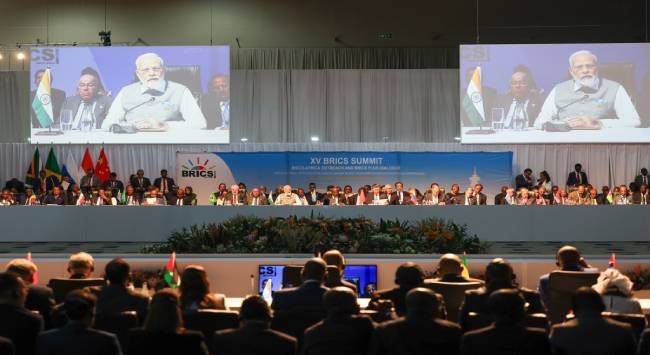Summary
In the aftermath of the 15th BRICS Summit held in South Africa, India’s focus on multilateralism through non-western political forums such as BRICS requires political consideration. As most of these multilateral forums continue to be influenced by Chinese hegemony, India needs to re-evaluate its participation in such multilateral forums, adopting a clear-eyed strategic analysis of how such forums can contribute to its national interests while moving away from its yesteryear’s idealism of non-alignment and third-world solidarity.
Brazil, Russia, India, China and South Africa met for the 15th BRICS summit in South Africa in August 2023. Since its inception in 2010, BRICS has propounded for greater democratisation of global decision-making, whether political, financial or technological. The inception of BRICS occurred during the apogee of United States (US) hegemony and unilateralism. All these states, especially the three Eurasian states of India, China and Russia, were heavily invested in creating greater autonomy in global affairs vis-à-vis the American power.
More than any other member, the future of BRICS depended heavily on the promise of the rise of India and China. China is, of course, the most significant economic powerhouse within the grouping. Even when it is five times the size of the Indian economy and the Indian economy is twice the size of the rest of the BRICS states, India’s gross domestic product growth rates have been higher than that of China in the last few years. New Delhi is slated to be the third largest economy in the world in the next decade, behind China and the US. BRICS rise, therefore, is mainly contingent on China and India rather than the rest of its members.
The success of BRICS will also depend significantly upon the bilateral relations between Asia’s two most populous nations. In 2006, when the idea of BRICS was incubated, India and China were enjoying a thaw in their otherwise chequered relationship. Built upon economic interdependence, the two countries had stabilised their boundary problems. Both were interested in maintaining the status-quo on the border. China’s gargantuan rise since has, however, significantly altered the context and content of the bilateral relationship. Today, India-China relations are on their nadir in the last four decades.
India’s focus on multilateralism through non-western political forums such as the BRICS, therefore, must consider these three political implications.
First, all such forums, including BRICS and the Shanghai Cooperation Organisation(SCO), will represent China’s interests far more than the rest of its members. China’s economic and political clout will far outweigh what India can bring to the table. The war in Ukraine has rendered Russia more or less an appendage to China. South Africa and Brazil, too, are far more economically dependent upon China. Thus, rather than challenging the Western dominance of the international system, BRICS is far more an instrument to bring a China-centric alternate global governance model. New Delhi must identify its national priorities between global multipolarity and Asian multipolarity. Insofar as non-Western multilateral forums become an agent of China’s influence, New Delhi needs to tread carefully. India’s lacklustre support for BRICS currency and a BRICS bank indicates its foreign policy dilemma.
Second, India also cannot abdicate from such multilateral forums altogether. It must continuously engage and provide alternative visions of multilateralism within these organisations. Both BRICS and SCO have become critical sites for India and China to engage diplomatically, even when the bilateral relations have soured drastically in recent years. Such multilateral forums provide avenues for direct engagement between the top leadership in a context where such meetings are politically sensitive for both Indian Prime Minister Narendra Modi and Chinese President Xi Jinping. During the G20 summit in Bali in November 2022 as well as the BRICS summit in South Africa in August 2023, New Delhi and Beijing were able to pursue bilateral discussions. The resultant directive on disengagement from the Line of Actual Control during the Johannesburg summit is a case in point.
Third, multilateral forums such as BRICS can genuinely articulate the priorities of the Global South and provide the necessary corrections to China’s non-transparent and often debt-driving economic initiatives such as the Belt and the Road Initiative . More importantly, they can help create a wedge between the BRICS members to render a clear attachment and commitment to China’s agenda impossible within these forums.
Therefore, India’s engagement with BRICS must be driven by a clear-eyed strategic analysis of what and how such forums can contribute to its national interests rather than yesteryear’s idealism of non-alignment and third-world solidarity. New Delhi should identify the focus of such multilateralism which should not only be the democratisation of global politics away from its Western domination but also render it insusceptible to the looming Chinese hegemony.
. . . . .
Dr Yogesh Joshi is a Research Fellow at the Institute of South Asian Studies (ISAS), an autonomous research institute in the National University of Singapore (NUS). He can be contacted at yogeshjoshi@nus.edu.sg. Ms Devyani Chaturvedi is a Research Analyst at the same institute. She can be contacted at devyani@nus.edu.sg. The authors bear full responsibility for the facts cited and opinions expressed in this paper.
Image: https://twitter.com/MEAIndia/status/1694669603593478525/photo/2
-
 More From :
More From :
-
 Tags :
Tags :
-
 Download PDF
Download PDF



